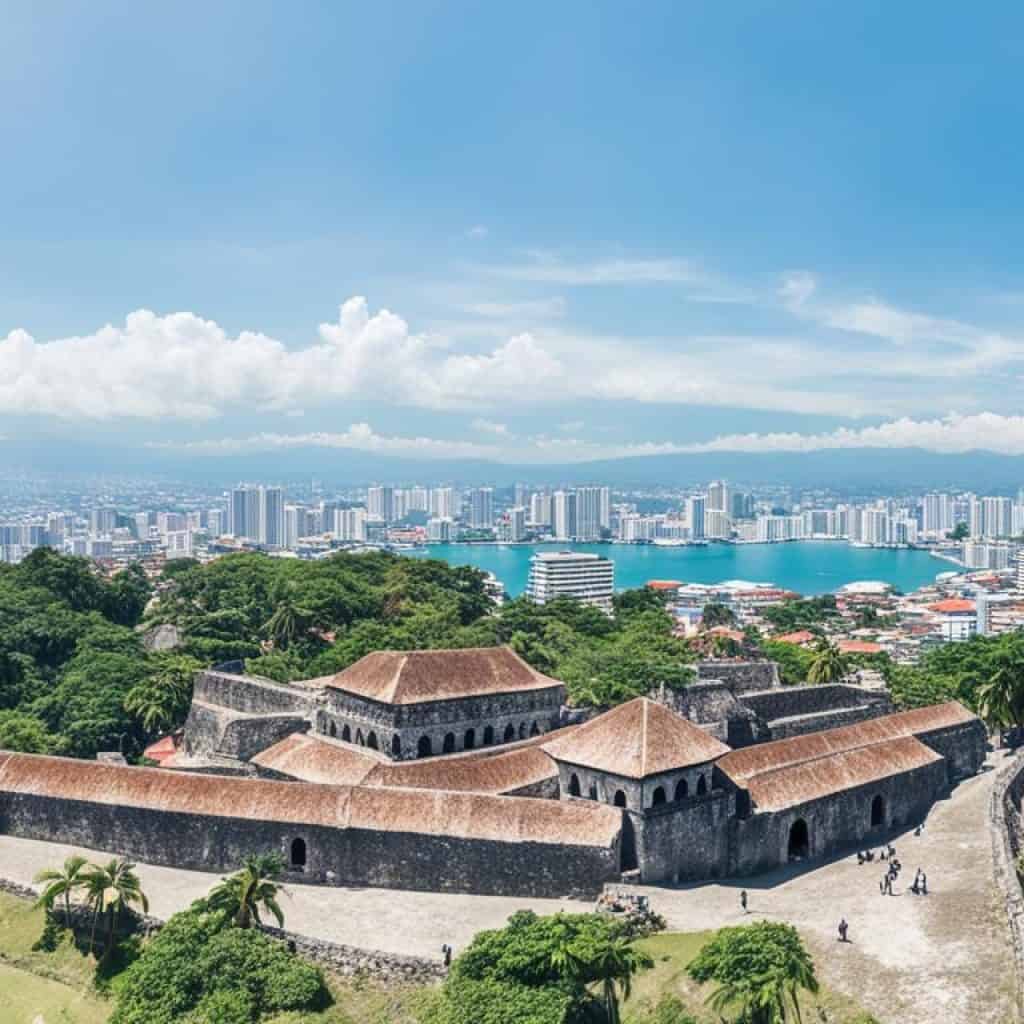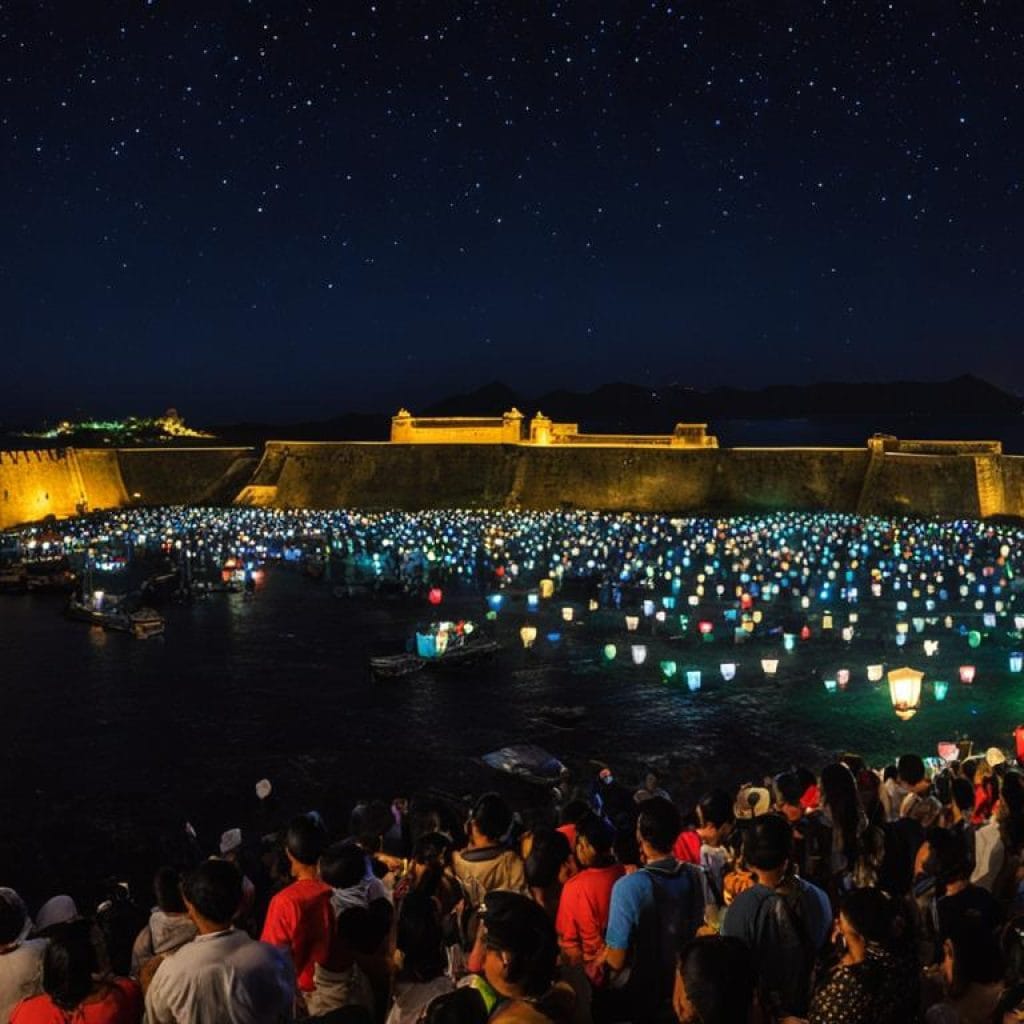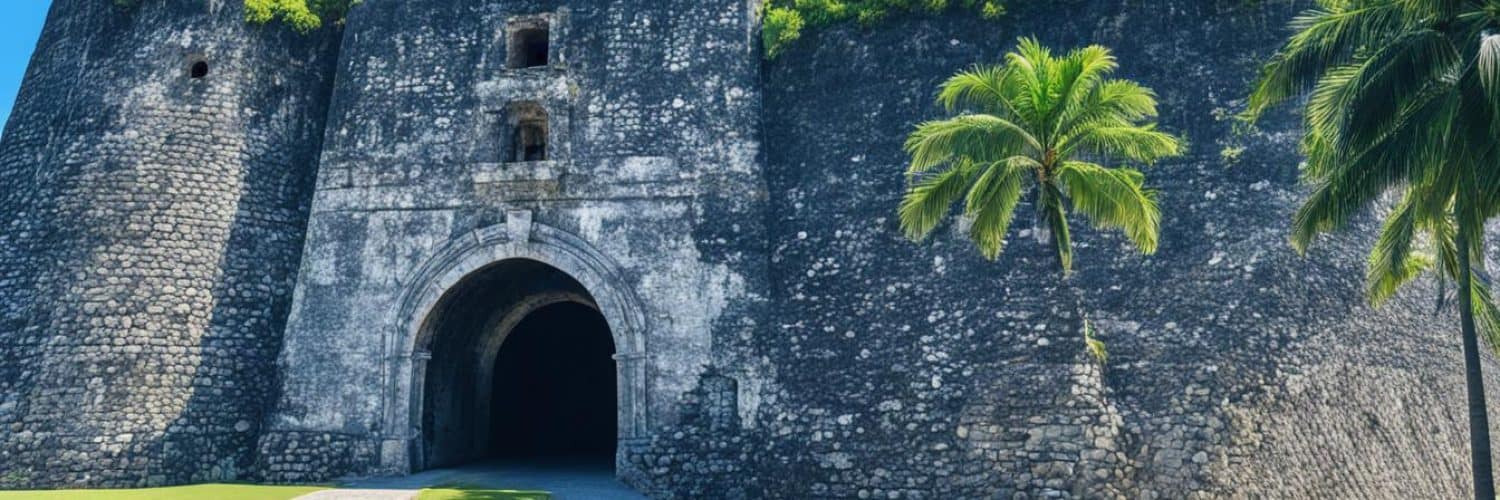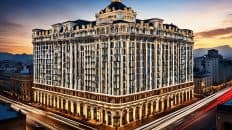Fort San Pedro, the vestige of Spanish legacy in the Philippines, stands proudly as a cornerstone of history in the bustling city of Cebu Philippines. This historical landmark is not just a relic of the past but a beacon of cultural heritage, inviting both locals and tourists alike to step back in time. With its distinctive triangular design and storied walls, Fort San Pedro encapsulates the rich tapestry of Cebu’s historical narrative, beckoning to those eager to experience a tangible piece of Philippine history.
Located at A. Pigafetta Street, this cultural heritage site offers an accessible journey to an era of exploration and colonial encounters. Whether you are a history enthusiast, a cultural wanderer, or simply looking for a unique experience, Fort San Pedro is an unmissable destination that promises to leave visitors enriched with knowledge and appreciation of the Philippines’ colonial timeline.
Please note: The following “Key Takeaways” are essential highlights from the section allowing readers to grasp the key aspects of Fort San Pedro.
Key Takeaways
- Fort San Pedro, a principal historical landmark in Cebu Philippines, stands as a testament to the country’s rich past.
- The fort’s unique triangular design showcases 16th-century military architecture and defense strategy.
- It serves as an approachable destination for those exploring Filipinos’ cultural heritage within Cebu City.
- This iconic fort invites visitors to witness the enduring legacy of the Spanish colonial era within its walls.
- An educational and awe-inspiring experience awaits at this cultural heritage site, integral to the Philippine historical fabric.
The Historical Significance of Fort San Pedro
Delving into the annals of the Spanish colonial era, one cannot overlook the monumental role of Fort San Pedro, Cebu’s bastion of history. Erected in 1565 under the leadership of Miguel López de Legazpi, this fortification not only served as a defense fortress but also as a cornerstone in the Philippines’ colonial history. Its enduring presence has made it a tangible symbol of the bygone colonial epoch and an encapsulation of Cebu’s rich historical diversity.
The Birthplace of Spanish Influence in Cebu
Fort San Pedro’s inception marked the dawn of a new era in Cebu, forever altering its cultural and political landscape. Standing as a silent witness to the unfolding of the Spanish regime, this stone edifice signifies the strength and lasting influence of Spain’s extensive colonization efforts in the region.
Fort San Pedro’s Role in the Philippines’ Colonial Past
Throughout various stages of history, Fort San Pedro has transformed, mirroring the tumultuous shifts wrought by time. From its early days as a wooden structure to the impressive stonework it is today, the fort has transitioned from a military holdfast to a place of imprisonment during the Philippine Revolution, and then into a bastion for the burgeoning Filipino revolutionary movement. Its walls have seen usage as the American Warwick Barracks, instituting Fort San Pedro as not just a military installation but also a social and civic center.
Over the centuries, Fort San Pedro has borne different masks – a watchtower, a penal colony, a shelter, a school, and now, a museum preserving its own poignant tale.
Fort San Pedro’s Unique Architecture and Design
The fortification of Fort San Pedro stands as a testament to the innovative vision of 16th-century military strategy. Its unique architecture is not merely a feature of aesthetic significance but a structural embodiment of historical prowess, reflected in its distinct triangular bastion fort configuration.
Characterized by its geometric precision, the fort’s layout was intended to optimize defense. The triangular shape, an uncommon sight in modern fortifications, allowed defenders a panoramic presence across the battlefield, a necessary advantage during historical sieges.
Triangular Bastion Fort: A Defense Masterpiece
The triangular bastion fort of San Pedro, with its intimidating walls and commanding bastions, serves as a reminder of the military ingenuity of the past. The concept behind the design was clear—position cannons at each corner to cover all angles of approach, leaving no blind spots for potential invaders. This architectural ingenuity has made the fort not simply a structure, but a work of military art.
The Resilient Stones and Mortar of Cebu
The robustness of Fort San Pedro’s walls is attributed to the use of indigenous coral stone and stone mortar. These materials not only provided strength to the structure but have also withstood the test of time, offering insights into the natural history of the region as they encapsulate marine fossils within their dense composition.
| Bastion | Name Origin | Significance |
|---|---|---|
| La Concepcion | Spanish: ‘The Immaculate Conception’ | Dedicated to the honour of the Virgin Mary |
| Ignacio de Loyola | Founder of the Jesuits | A nod to the religious influence during Spanish colonization |
| San Miguel | Spanish: ‘Saint Michael’ | Symbolizes protection and strength, Michael being an archangel |
The bastions, named La Concepcion, Ignacio de Loyola, and San Miguel, each pacify a different aspect of the fort’s historical and cultural narrative. By understanding the resilience and resourcefulness showcased in the construction of Fort San Pedro, one gains a deeper appreciation for the legacy left by our ancestors through unique architecture and strategic innovation.
Cultural Heritage Site: Fort San Pedro, Cebu Philippines
At the core of Cebu City’s tapestry lies Fort San Pedro, a cultural emblem interwoven with a historical narrative that speaks volumes about the Philippines’ enduring legacy. As a prime tourist attraction, this bastion of history enchants with its ancient walls and intriguing exhibits. Fort San Pedro’s role in safeguarding the cultural significance of Cebu is undeniable, as it serves to educate and fascinate visitors from around the globe.

The fort’s museum is a journey in itself, distilling Cebu’s history through a curated selection of displays and artifacts that paint a vivid picture of how the city has evolved. Here, every coral stone block and historical relic has a tale to tell, allowing Fort San Pedro to offer not just a stroll through history, but an all-encompassing experience of the cultural significance woven into the very essence of Cebu City.
| Fort Feature | Cultural Significance | Visitor Experience |
|---|---|---|
| Bastions | Symbolic representation of Cebu’s resilience | Panoramic views of the city and ocean |
| Museum Exhibits | Chronicle of Spanish colonial history | Insight into artifacts from Cebu’s transformations |
| Architecture | Layout reflecting military acumen of the past | Exploration of unique triangular design |
| Coral Stones | Insights into ancient marine life and geology | Close-up observations of the natural materials used in construction |
Visitors to Fort San Pedro not only walk through an integral piece of Cebu’s rich tapestry but also contribute to the ongoing storyline of this magnificent cultural heritage site. Each step taken within its walls is a step shared with centuries of history, ensuring that the fort remains a cornerstone of historical narrative and cultural significance in Cebu City.
Visiting Fort San Pedro: A Journey to the Past
Embark on a historical adventure as you step into the hallowed grounds of Fort San Pedro, where the legacy of Spanish Conquistador Miguel López de Legazpi is palpably felt amidst the ancient walls. A visit to this iconic historical monument is a dive into the rich tapestry of Filipino history and the indelible mark left behind by colonial conquests and native resilience.
Experience the Legacy of Spanish Conquistador Miguel López de Legazpi
Striding through the imposing gates, visitors encounter a world frozen in time, a direct experience of the enduring legacy that continues to captivate history enthusiasts and casual tourists alike. Fort San Pedro’s sun-kissed bastions tell the tale of a strategic military stronghold that has withstood the test of time and the changing tides of power.
The Transformation From Military Fortress to Public Museum
The transformation from a bulwark meant for war to a serene repository of culture and history is a testament to the Filipino spirit of reclamation and preservation. What once echoed with the footsteps of soldiers now resonates with the curious murmurs of tourists, as the former military fortress stands proudly as a must-visit destination. Within its walls, the public museum houses a breathtaking array of artifacts, including an original flag from the fateful Battle of Manila Bay, anchoring the narrative to a pivotal moment in 1898.
- Explore the diverse array of historical exhibits and artifacts.
- Immerse yourself in the stories of past battles and the evolution of a nation.
- Relive the cultural heritage through preserved legacies of colonial times.
Fort San Pedro’s journey, from its inception to its present-day prominence, is an inspiring reminder of heritage persistence. It beckons everyone to learn, reflect, and appreciate the intricacies of a past that has shaped the present. As guardians of history, we continue to revel in the site’s splendor and significance.
The Enigmatic Presence of Our Lady of the Fort
Amid the historical contours of Fort San Pedro, stands a figure steeped in devotion and history—Our Lady of the Fort, also celebrated as The Virgin of Remedies. A beacon of cultural heritage and spiritual comfort, her story interweaves with local legends and the faith of countless pilgrims who have set foot within the fort’s venerable bounds.
Visitors to Fort San Pedro encounter the sacred image which is said to be the second oldest representation of the Virgin Mary in the archipelago. There’s a sense of mystery that surrounds Our Lady of the Fort, with narrations of her miraculous emergence from within a well in the fortress and the enigmatic gifting of her likeness to the Queen of Cebu by the Spanish conquerors. Despite the original statue being lost due to the ravages of World War II, its enduring replica continues to captivate onlookers and inspire the faithful.
Today, the image presides over an ancient well, now transformed into a wishing well, collaborating with tradition and folklore to form an experience that is intrinsically tied to the fort’s cultural heritage. This aspect of local tradition is not only a reflection of the religious significance of The Virgin of Remedies but also it anchors the fort as a site where history and spirituality converge.
- Second oldest Marian image in the Philippines
- Symbol of spiritual reverence and historical legend
- Replica a focus of contemporary devotion and culture
- Wishing well a testament to the blend of history and local tradition
In visiting this historic landmark, one does not simply walk the grounds of a bygone era, but rather, partakes in a living tradition that has weathered the test of time. The presence of Our Lady of the Fort is more than an element of interest; it stands as a profound reminder of the fusion between the Philippines’ rich history, religious devotion, and the vibrant tapestry of cultural heritage that continues to define Cebu and its people.
Museum Exhibits: Preserving Cebu’s Colonial Narrative
Fort San Pedro’s museum is a treasure trove of historical artifacts that invite visitors to delve deep into Cebu’s storied past marked by Spanish colonialism and the Philippine Revolutions. As one enters the hallowed halls, they are greeted by a collection that narrates the enduring spirit of the Philippines through tangible remnants of its history.
Artifacts and Galleries: A Sneak Peek into Spanish Rule
The galleries within this historical fortress cum museum offer an unparalleled retrospective of the Spanish era. Each exhibit, from the delicate earthenware to the finely crafted porcelain, stands as a testament to the profound influence Spain had on the cultural and societal fabric of the Filipino people. Intricate sculptures sourced from the period help to paint a textured portrait of times where colonial power dictated the rhythm of everyday life.
The Tale of Philippine Revolutions and Fort San Pedro
The role of Fort San Pedro during the Philippine Revolutions is dynamically showcased through an array of black and white photographs and personal testimonials. Visitors are transported back to this tumultuous era, where every brick of the fort bore witness to the resilience and eventual triumph of the Filipino revolutionary forces. The visual journaling of these events juxtaposed with actual objects from the period creates a vivid mosaic that eloquently speaks of the Philippines’ arduous journey towards sovereignty.
By observing these museum exhibits, one not only learns about the intricate history of Cebu and the greater Philippine archipelago but also appreciates the fort itself, as more than mere walls—it’s a silent chronicler of centuries and a guardian of stories waiting to be told.
A Photographer’s Haven: The Remarkable Vistas from Fort San Pedro
Amidst the rich historical backdrop of Cebu City, Fort San Pedro stands out as not just a testament to the past, but as a beacon for photography lovers. The blend of history, ecological treasures, and the raw scenic beauty encapsulated within its walls make it a top sightseeing spot. Whether you are a seasoned photographer or an amateur with a keen eye for beauty, the fort invites all to capture its splendor.
The lure of the ocean’s horizon against the fortifications offers a portrait of nature’s majesty; each snapshot is a harmony of natural and man-made wonders. As a true photographer’s haven, the perspectives you’ll find here are as enriching as they are diverse.
Embracing the Scenic Beauty of Cebu City’s Coastline
The vistas from Fort San Pedro are a love letter to the scenic beauty of Cebu City’s coastline. Photographers are drawn to this locale as the sun casts golden hues over the azure waters, creating moments that beg to be immortalized. These are views that convey the tranquil power of the ocean, highlighting the serene charm of the Philippine coast.
The Majestic Views from the Fort’s Bastions and Walls
The fort’s bastions and walls serve as vantage points for majestic views that can leave an indelible mark on any observer. Stand atop these historic structures, and you’ll find a panoramic token of Cebu’s present woven with the threads of its rich heritage. It’s no surprise that this fortress is consistently touted as a top sightseeing spot, with layered histories hidden in plain sight amidst its stony embrace.
- Morning light reveals the coral textures of the fort’s limestone, encapsulating geological time.
- Sunset transforms the sky, casting a mesmerizing glow worth capturing.
- The night sky brings a peaceful solitude, contrasting the day’s vibrancy with stark, ethereal darkness.
For anyone seeking to catch a glimpse of Cebu’s essence, to hold a moment of its splendor in time, Fort San Pedro offers a canvas of endless possibilities. Here, every shot tells a story, each framed by the walls of a place that has seen history unfold—a true feast for any visual storyteller’s lens.
Fort San Pedro: A Top Sightseeing Spot for History Buffs
Stepping into the hallowed grounds of Fort San Pedro is like leafing through the pages of a rich narrative, where each artifact, painting, and exhibit whispers tales from the Spanish colonial era. This historical landmark is the cornerstone for those keen on unravelling the intricacies of Cebu’s past and witnessing a museum’s rich collection come to life.
Discovering the Museum’s Rich Collection
Visitors are greeted with an array of cultural treasures upon entering the museum at Fort San Pedro. The sight of Spanish-era paintings transports onlookers to a time where artistry and colonial life intertwined. Detailed models of antiquated Spanish ships captivate the imagination, flaunting the navigational prowess and seafaring legacy of a bygone epoch.
Amongst the museum’s offerings are carefully preserved artifacts that paint a vivid picture of the daily life during the Spanish rule. Each piece, whether it be a vintage coin, a fragment of pottery, or a rusted cannonball, serves as a puzzle piece to the grand mosaic of Cebu’s history.
Understanding Cebu’s Place in the Spanish Colonial Era
The influence of the Spanish colonial era on Cebu and its people is immeasurable. As history buffs explore Fort San Pedro, they gain a deeper comprehension of Cebu’s transformation under colonial rule. The museum’s alluring narratives recount the island’s tumultuous journey through times of conquest and rebellion, all of which shaped the vibrant culture and character observable in Cebu today.
A visit to Fort San Pedro is more than a leisurely stroll through a historical site; it is an immersive experience that beckons to the curious mind, eager to grasp the signficance of this island during the waves of foreign domination and its undying spirit of resilience, which defines its modern identity.
Local Events and Festivities at Fort San Pedro

Fort San Pedro is not just a portal to the past; it’s a vibrant centerpiece for local events and festivities that capture the heart of Cebu’s culture. Its storied bastions and sunbaked courtyards offer an atmospheric venue for a variety of gatherings, all steeped in history yet brimming with contemporary fervor.
Celebrating Cebu’s Vibrant Culture within Historic Walls
Within the ancient ramparts of Fort San Pedro, the blend of old and new is palpable as the fort hosts an array of cultural activities and gatherings. These events are not only a celebration of the present but also an homage to the rich tapestry of the island’s heritage.
Fort San Pedro as a Venue for Heritage Nights and Reenactments
The fort takes center stage during heritage nights, a time when history is replayed through reenactments of significant events that tell the story of Cebu’s yesteryears. These dramatizations provide a powerful visual narrative, preserving the lessons of history through the arts.
| Event Type | Description | Date(s) |
|---|---|---|
| Heritage Nights | Immersive cultural experience with historical plays and traditional music. | Typically held during significant anniversaries and cultural weeks. |
| Festivals | Public celebrations with dance, food, and parades reflecting Cebu’s diverse traditions. | Varies, with major festivals occurring annually. |
| Reenactments | Dramatized retelling of historical events significant to Fort San Pedro’s legacy. | Often staged on historical dates or during educational events. |
| Community Gatherings | Local engagements such as weddings, birthdays, or societal meetings set against a historical backdrop. | Booked upon request throughout the year. |
The embrace of these traditions and modern celebrations within the fortified confines of Fort San Pedro demonstrates an enduring appreciation for Cebu’s past, as well as a commitment to its thriving future as a cultural hub.
Conclusion: Fort San Pedro’s Enduring Legacy
Embraced by history enthusiasts and travelers alike, Fort San Pedro is not just a landmark but a vibrant beacon of Cebu’s historic core. Its storied walls resonate with the events that have carved the national identity of the Philippines, making it a pivotal must-visit destination for anyone looking to understand the enduring legacy of Filipino culture. The fort’s significance stretches far beyond its age-old foundations; it is a celebration of resilience, a place where the past and present converge amidst panoramic views and impressive bastions.
Why Fort San Pedro is a Must-Visit Destination
The allure of Fort San Pedro lies in its ability to educate and captivate. Visitors are transported to bygone eras through a wealth of historical artifacts, feeling the presence of the various foreign powers that shaped today’s Philippines. A site where beauty and history intermingle, the fort offers scenic vistas and a tranquil ambience that appeal to sightseers and photographers, making it an indispensable part of any travel itinerary in Cebu.
Fort San Pedro’s Contribution to Philippine National Identity
Fort San Pedro’s place in the fabric of Philippine national identity is undisputed. It stands as a monument to the fortitude of the Filipino spirit and a testament to the nation’s complex historical journey. With every bastion and artifact, visitors gain a deeper appreciation for the rich tapestry that defines the country today. The enduring legacy of this cultural gem continues to enthrall and inspire, marking Fort San Pedro as a timeless emblem of pride for the Philippines.
FAQ
What is Fort San Pedro and why is it significant?
Fort San Pedro is a historical landmark and cultural heritage site located in Cebu City, Philippines. It represents the birthplace of Spanish influence in Cebu, serving as a military defense fortress during the Spanish colonial era and playing significant roles through the Philippines’ colonial history.
What makes Fort San Pedro’s architecture unique?
The fort features a unique triangular bastion fort design, which was a defense masterpiece of the 16th century. This strategic geometric structure, along with its resilient construction using stone mortar and indigenous coral stone, showcases the architectural prowess and military engineering of the Spanish colonial period.
Can tourists visit Fort San Pedro?
Yes, Fort San Pedro is a popular tourist attraction and a must-visit destination in Cebu City. It is open to the public and offers a glimpse into the historical narrative and cultural significance of the region through its museum exhibits and preserved structures.
What can visitors expect to see in Fort San Pedro?
Visitors can explore the legacy of Spanish Conquistador Miguel López de Legazpi, admire the transformation of the fort from a military fortress to a public museum, and witness the enigmatic presence of Our Lady of the Fort. The museum within houses artifacts, galleries, and exhibits that provide a sneak peek into Spanish rule and the Philippine Revolutions.
Are there any notable exhibits or artifacts at the Fort San Pedro Museum?
Yes, the museum contains a range of exhibits including Spanish-era paintings, models of old Spanish ships, black and white photographs of historical significance, and various artifacts that portray the influence of Spanish colonialism in the Philippines.
Is Fort San Pedro a good spot for photography?
Absolutely! Fort San Pedro is a photographer’s haven. It offers remarkable vistas and panoramic views of Cebu City’s coastline, scenic beauty, and majestic views from the fort’s bastions and walls, making it a top sightseeing spot for photography enthusiasts.
What types of local events and festivities take place at Fort San Pedro?
Fort San Pedro is a lively stage for local events and festivities that highlight Cebu’s vibrant culture. Celebrations like Gabii sa Kabilin, heritage nights, reenactments, and various social functions such as weddings and birthdays are held within the fort’s historic walls.
Why should Fort San Pedro be on my list of places to visit in the Philippines?
As a symbol of the enduring legacy and national identity of the Philippines, Fort San Pedro offers a comprehensive insight into the nation’s history, the cultural transformations over the centuries, and presents an enriching, educational, and picturesque experience. It’s a place where the past meets the present and provides a profound understanding of Filipino heritage.











Add comment